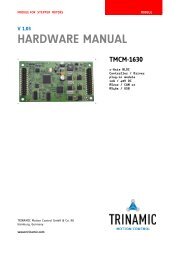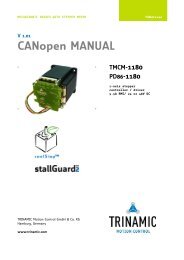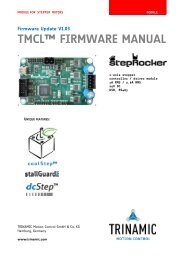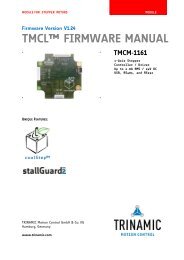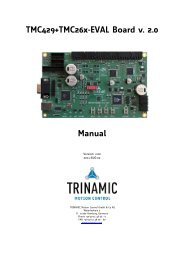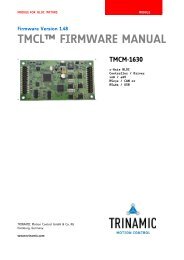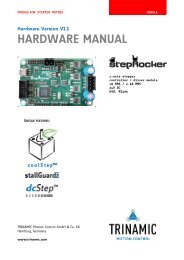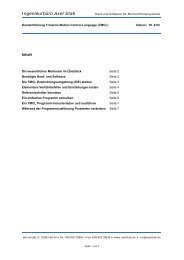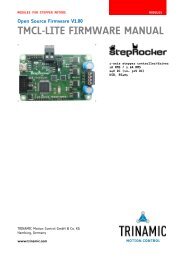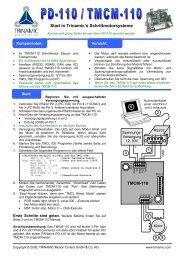TMCL™ Firmware Manual - Trinamic
TMCL™ Firmware Manual - Trinamic
TMCL™ Firmware Manual - Trinamic
You also want an ePaper? Increase the reach of your titles
YUMPU automatically turns print PDFs into web optimized ePapers that Google loves.
PD-109-57 V2 TMCL <strong>Firmware</strong> <strong>Manual</strong> (V1.00/2010-FEB-18) 91<br />
9 Hints and tips<br />
This chapter gives some hints and tips on using the functionality of TMCL, for example how to use and<br />
parameterize the built-in reference point search algorithm.<br />
9.1 Reference search<br />
The built-in reference search features switching point calibration and supports of one reference switch per<br />
axis. The internal operation is based on three individual state machines (one per axis) that can be started,<br />
stopped and monitored (instruction RFS, no. 13). The settings of the automatic stop functions corresponding<br />
to the switches (axis parameters 12 and 13) do not have any influence on the reference search.<br />
Left Stop<br />
Switch<br />
Negative<br />
Direction<br />
Traveller<br />
Reference<br />
Switch<br />
Positive<br />
Direction<br />
Definition of the switches<br />
Right Stop<br />
Switch<br />
Selecting the referencing mode (axis parameter 193): in modes 1 and 2, the motor will start by moving<br />
left (negative position counts). In mode 3 (three-switch mode), the right stop switch is searched first to<br />
distinguish the left stop switch from the reference switch by the order of activation when moving left<br />
(reference switch and left limit switch share the same electrical function).<br />
Until the reference switch is found for the first time, the searching speed is identical to the maximum<br />
positioning speed (axis parameter 4), unless reduced by axis parameter 194.<br />
After hitting the reference switch, the motor slowly moves right until the switch is released. Finally the<br />
switch is re-entered in left direction, setting the reference point to the center of the two switching<br />
points. This low calibrating speed is a quarter of the maximum positioning speed by default (axis<br />
parameter 195).<br />
In Figure 9.1 the connection of the left and the right limit switch is shown. Figure 9.2 shows the<br />
connection of three switches as left and right limit switch and a reference switch for the reference<br />
point. The reference switch is connected in series with the left limit switch. The differentiation between<br />
the left limit switch and the reference switch is made through software. Switches with open contacts<br />
(normally closed) are used.<br />
In circular systems there are no end points and thus only one reference switch is used for finding the<br />
reference point.<br />
REF_L_x REF_R_x<br />
left stop<br />
sw itch<br />
motor<br />
traveller<br />
Figure 9.1: Two limit switches<br />
right stop<br />
sw itch<br />
left stop<br />
sw itch<br />
Copyright © 2010, TRINAMIC Motion Control GmbH & Co. KG<br />
REF_L_x REF_R_x<br />
motor<br />
traveller<br />
reference<br />
sw itch<br />
right stop<br />
sw itch<br />
Figure 9.2: Limit switches with extra<br />
reference switch<br />
REF_L_x<br />
ref sw itch<br />
motor<br />
eccentric<br />
Figure 9.3: Circular<br />
system



